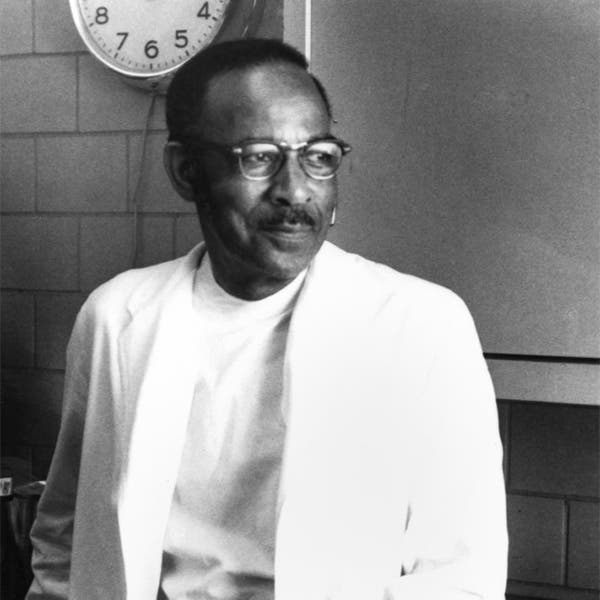Scientist of the Day - Vivien Thomas
Vivien Theodore Thomas, an African American laboratory and surgical technician, was born Aug. 29, 1910, in rural Louisiana. He grew up in Nashville, where his family moved when he was young, learned carpentry from his father, and was saving money to attend college when the Depression hit and his savings were wiped out. He found a job working as a night assistant in the animal laboratory of Dr. Alfred Blalock at Vanderbilt University, where he slowly impressed Blalock with his skill in doing surgical operations on animals. However, his pay scale was that of a janitor, and although he never gave up his dream of going to college, he was able to save little of his minimal wages.
The first investigations conducted by Blalock and Thomas were into treatment for traumatic shock, which was not well understood in the 1930s. They discovered that the best remedy was immediate fluid replacement, a discovery that, when accepted, saved many lives in the upcoming war. They also began expeimenting with heart surgery on animals, at a time when heart surgery in humans was seldom done.
When Blalock was invited to Johns Hopkins Medical School in 1941, he insisted on bringing Thomas with him, although Hopkins was more segregated than Vanderbilt, and life on campus was difficult for Thomas. Thomas was again in charge of the animal laboratory, although he often functioned as a surgical assistant to Blalock. Blalock was approached in 1943 by a pediatric cardiologist at Hopkins, Helen Taussig, who was looking for a surgical procedure to correct a birth defect known as tetralogy of Fallot, where the major blood vessels emerging from the heart are incorrectly joined, so that the blood is not properly oxygenated, and the baby is cyanotic, or blue. Blalock wondered if it were possible by surgical intervention to shunt blood from one vessel to another, allowing blood to flow more easily to the lungs. He gave Thomas the problem, and Thomas solved it, doing over 200 surgeries on dogs to perfect the technique. In 1944, Blalock (who had done only one operation on a dog himself), undertook to install the shunt in a human baby, with Thomas on a stool right behind him, directing his boss. The operation was successful, and soon they were performing hundreds of such surgeries, and the "blue babies" were blue no more. The procedure came to be referred to as the "Blalock-Taussig shunt surgery," with no mention of Thomas, who developed the surgical methods, but received no eponymic reward.
Thomas's relationship with Blalock was a complicated one. Blalock clearly respected Thomas, and defended his presence in the lab, at a time when he was the only African American on the staff who was not a janitor. Blalock made Thomas head of the surgical laboratories, where he trained many future surgeons. But Blalock never paid Thomas a suitable salary, and he seldom referred to Thomas's important role in perfecting the shunt surgery, either publicly, or in his publications. I have not been able to uncover the circumstances behind our third photo, but it is rare to find Thomas being given equal footing with Blalock and Taussig, the other two individuals in the photo.
When Blalock died in 1964, Thomas stayed on at Hopkins as supervisor of surgical laboratories. He was given an honorary doctorate in 1976 and the title of instructor of surgery. Some of his former surgical pupils, now distinguished surgeons, commissioned a portrait ot Thomas in 1968, which now hangs, ironically, in the Blalock Building at Hopkins. Thomas’s important role in the surgical successes of Blalock and Taussig did not come to light until an article was written about him in the popular press in 1989. This inspired a PBS American Experience documentary, Partners of the Heart, in 2003, and in 2004, a made-for-television film, Something the Lord Made, with Alan Rickman as Blalock and Mos Def as Thomas. The title of the film came from a remark that Blalock supposedly made, upon viewing a beautiful surgical procedure performed by Thomas, "It looks like something the Lord Made." I have not been able to find the documentary or the film to view, although it is said that the scene where Thomas stands on a stool and directs Blalock during the first operation of 1944 is a memorable one in both. I can certainly believe that.
It is lamentable, even tragic, that Thomas was never able to realize his dream of becoming a doctor and surgeon himself, and that he had to put up with rampant intolerance and racism throughout his career. But in the end, you have to immensely admire this man, who tolerated the things he could not change with grace, and then changed the things he could with wisdom and expertise. He made a great difference, to the children whose lives he saved, to the surgeons he instructed, and eventually, to the African American medical students he counseled and inspired.
There have been a few attempts recently, in the medical literature, to change the name of the “Blalock-Taussig shunt” to the Blalock-Thomas-Taussig shunt.” Although this shunt is used only infrequently now, as better procedures have been developed in the past half-century, it would be nice if it were referred to by the more appropriate name.
Thomas died on Nov. 25, 1985, at the age of 75, and is buried, with his wife Clara, in Maryland National Memorial Park, in Laurel, Maryland.
William B. Ashworth, Jr., Consultant for the History of Science, Linda Hall Library and Associate Professor emeritus, Department of History, University of Missouri-Kansas City. Comments or corrections are welcome; please direct to ashworthw@umkc.edu.










